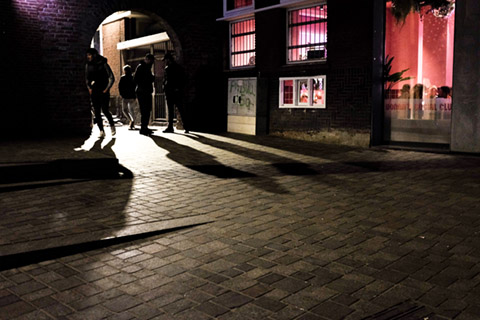
Why you’d rather avoid certain streets
Scary places
There are a few scary places between the train station and the city centre. The first one is the side of the Pathé theatre, in the Ubbo Emmiusstraat next to the Subway. Homeless people can often be seen begging for money here, but there are also men who hide their faces in hoodies who whisper things at the people passing by. ‘I’ve heard a lot of stories from friends who’ve been harassed there’, says Eline Santema, an American Studies student. She always makes sure to pedal extra fast when passing the corner.
A little farther down, the intersection of the Folkingestraat and the Nieuwstad, Groningen’s red-light district, is another scary place, says medical student Anne. The corner is home to a group of men, giving it a menacing atmosphere, she says. One time, the situation became particularly threatening. ‘I was walking home to the city centre from the train station at night and a man started following me and whispering to me: Where are you sleeping tonight? Do you want to come with me?’
Noor, a student of international relations, also points to the Nieuwstad as a place where people call after her. ‘I always put my keys in between my fingers when I walk by there.’
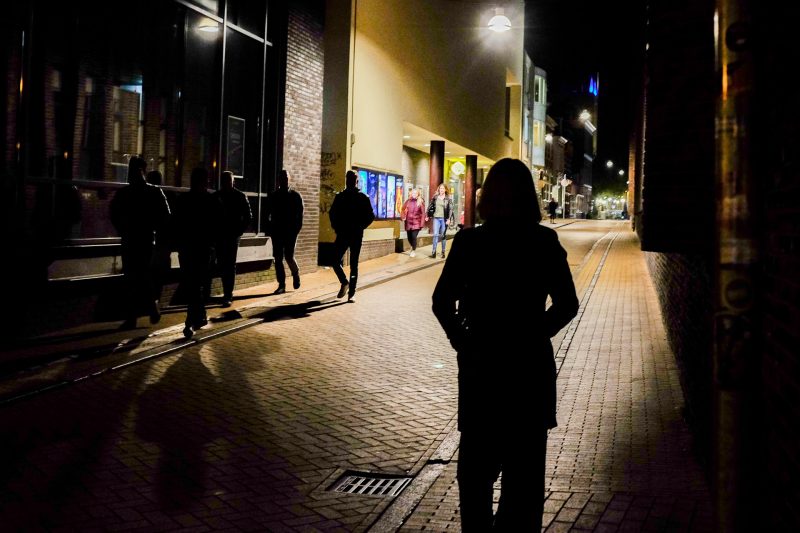
In the Ubbio Emmiusstraat next to Subway men in hoodies whisper at passers-by.
Enforcement
The city is aware that the intersection is an issue, says municipal spokesperson Hans Coenraad. Both visitors and Stadjers have reported the people who hang out there as a nuisance. ‘We installed cameras six months ago and we’re trying to tackle the issue through enforcement.’
They’re mainly focusing on prevention, says Coenraad: enforcement officers talk to the homeless people or addicts, offering them help.
I always put my keys between my fingers
Medical student Emma thinks more light would also help people feel safer. She always feels unsafe biking through the city in the dark, no matter where. Because of that, she always keeps her phone to her ear, so people think she’s talking to someone. ‘I don’t care if I get a fine.’
Students say it doesn’t really matter where they are; they simply feel unsafe at night. But especially narrow streets are scary, says Nynke de Boer, pre-master student of clinical psychology.
Empty buildings
According to assistant professor of spatial planning and environment Elen-Maarja Trell, it’s because the buzz of the day is gone. ‘The buildings are empty of workers and most people are in bed, so there’s no one on the street who’d be able to help you if something happens.’
That’s also why people tend to feel less safe at the back of a building when its front faces the street. Combating scary places starts with designing a city or neighbourhood. Most city planners focus on the economic or environmental side of spatial planning, says Trell, such as solar panels and whether the marketplace will have trees. But improving social cohesion is just as important, she feels.
One example of this is the Noorderplantsoen, where the city has placed tables so people have somewhere to sit down without being forced to order a drink. ‘That reduces people’s anonymity and stops them being afraid of “the other”.’ Adding more greenery to a neighbourhood also improves people’s sense of safety, says Trell. ‘Green spaces make people feel less stressed.’
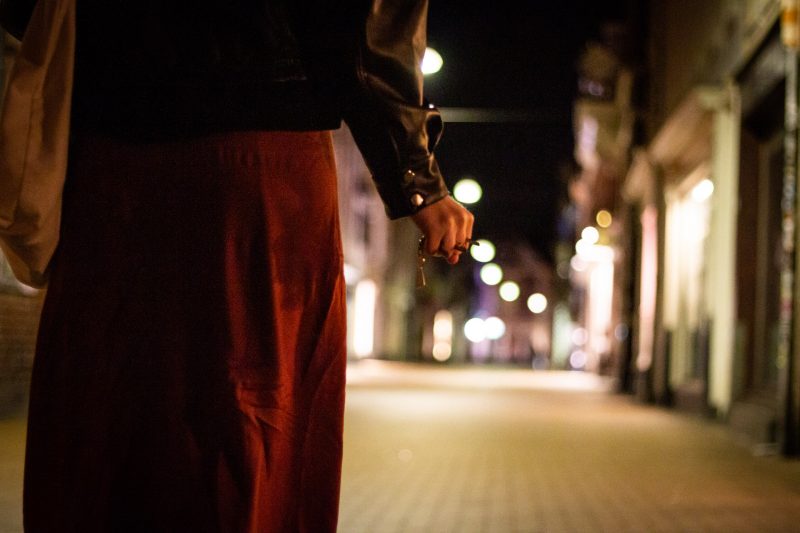
Passing by the Nieuwstad with your keys in your hand.
Unnoticed
Unsavoury types like to hang around in places with as few eyes on them as possible, says Trell. That way, the general public doesn’t notice them, allowing them to make their deals. One such place is the Martini churchyard: it’s shut off from the main roads by the back of the Martini church and town hall.
Marielle, who studies English language and culture, prefers to avoid the place. She once passed it with her mother when a group of men started yelling at her. They made remarks of a sexual nature, she says, ‘and they asked my mother if she was looking for a son-in-law’.
There’s no one out there to see you and come to your rescue
But even places with plenty of surveillance can feel unsafe, such as the Poelestraat or the Peperstraat. While the police put up cameras with smart sensors that sound the alarm in case of trouble and the police patrol the area a lot, people still get harassed and yelled at by drunk people. American studies student Veerle van de Put thinks it would help if ‘enforcers would actually talk to people when they’re harassing others’.
It would also make her feel safer if there were more enforcement officers around, says Veerle, but she understands it’s not easy. ‘We have a limited capacity’, confirms the municipal spokesperson, ‘so we need to distribute officers around the city as best we can.’
Priority locations are determined ‘through previous incidents and people on the street who have a good overview’, Coenraad explains. In the end, the mayor, the public prosecutor and the police chief decide where to deploy the officers.
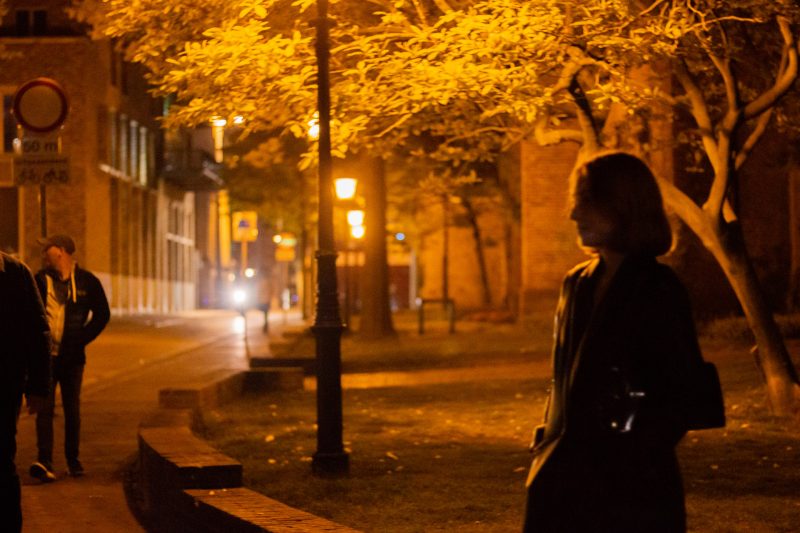
Out of sight at the Martinikerkhof.
Bystanders
Andra Buciu, a master student of international law and human rights, was once saved by a bystander. She was getting food after she’d been out partying, and an older man pulled her towards him and asked her to come with him. ‘I had to fight him off, until the guy behind the counter came to my rescue.’
That’s exactly why cameras don’t feel as safe as the eyes of real people looking out their windows, says Trell. They can respond in real time, while a camera can’t.
It would really help if bystanders paid more attention to people feeling unsafe
But bystanders don’t always help out. Student of economics and business economics Samantha Rogerson was once attacked early in the evening by a man with a screwdriver in the Folkingestraat. The man eventually let her go without hurting her, but she was shaken up. Even though it was still light out and there were people around, no one did anything. ‘It would really help if bystanders paid more attention to people feeling unsafe. As long as they’re willing to intervene, of course.’
Privacy
Her fellow economics student Maria Nguyenova agrees. She had an unpleasant experience in the Oosterstraat, where she was being accosted by a woman who was clearly under the influence of something. ‘It was late afternoon in September. There were plenty of people around, but that apparently doesn’t mean much.’
Should more cameras be installed to increase people’s sense of security? While this action was taken at the Nieuwstad, it can’t be implemented just like that, says Coenraad. Cameras are quite the intrusion of privacy, and the city would rather focus on preventative measures.
But putting up cameras, which Coenraad calls the final piece of enforcement actions, is on the agenda. Mayor Koen Schuiling wants to expand the number of cameras in the city. He wants them at the Grote Markt and the Vismarkt, as well as roads leading to both these locations. But the city council is still discussing the matter because of privacy issues. If the council is against it, the cameras will not be installed.
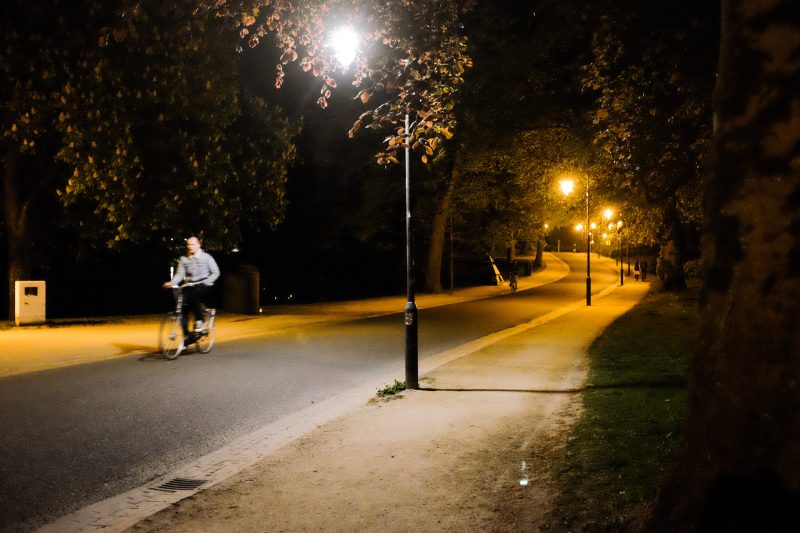
At night the Noorderplantsoen isn’t nearly as nice a place to hang out in.